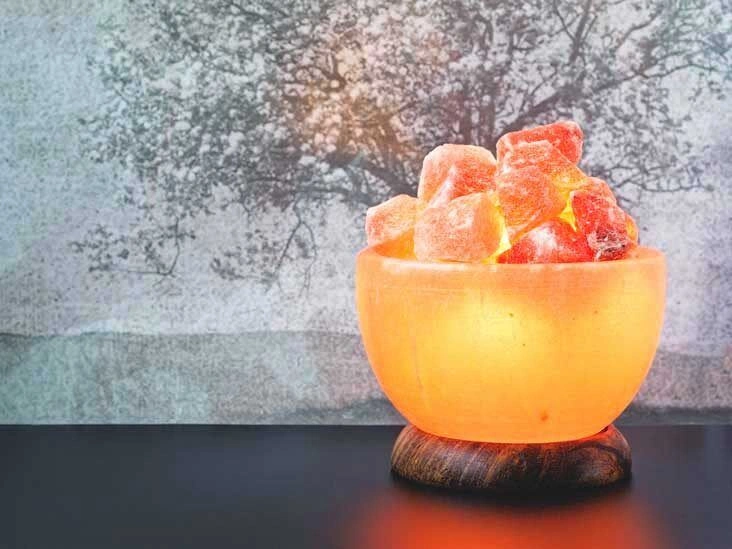Some people assert that Himalayan salt lamps can clean the air, lift your spirits, and improve sleep. Yet, scientific support for these asserted health perks is minimal.
Himalayan salt lamps are decorative lighting pieces sold for use in homes.
They’re sculpted from pink Himalayan salt and are promoted as having various wellness advantages.
Proponents claim these lamps can purify indoor air, ease allergy symptoms, enhance mood, and promote better sleep.
Still, many remain skeptical about whether these assertions hold up.
This article examines the evidence behind Himalayan salt lamps and separates fact from fiction.

What are Himalayan salt lamps and why do people use them?
Himalayan salt lamps are produced by fitting a light bulb inside sizable chunks of pink Himalayan salt.
They have a unique appearance and give off a warm, pinkish glow when switched on.
Authentic Himalayan salt lamps are crafted from salt extracted from the Khewra Salt Mine in Pakistan.
Salt from this region is thought to be millions of years old; although it resembles table salt chemically, trace minerals give it a pink hue.
Many people purchase Himalayan salt lamps simply because they like their appearance and the cozy atmosphere the pink light provides. Others are drawn by the purported health effects.
summaryHimalayan salt lamps are carved from the mineral-rich pink salt mined at Pakistan’s Khewra Salt Mine. Some buy them for decoration, while others believe they offer health benefits.
How do Himalayan salt lamps work?
Supporters say salt lamps confer health benefits because they act as “natural ionizers,” altering the electrical charge of the surrounding air.
Ions are particles that carry an electrical charge due to an imbalance of protons and electrons.
They form naturally in the atmosphere during various events. For instance, waterfalls, ocean waves, storms, natural radioactivity, and heat all generate air ions.
Ions can also be produced artificially by commercial air ionizers.
It’s been proposed that Himalayan salt lamps might produce ions by attracting water molecules that evaporate as a salt solution when warmed by the bulb, thereby creating mainly negative ions (2).
However, this idea has not been experimentally verified.
At present, it’s uncertain whether salt lamps generate ions in meaningful quantities, if they produce any at all.
summaryHimalayan salt lamps are claimed to change the charge of nearby air by producing ions that could be healthful. Yet, it is unclear whether they actually create any ions or enough to influence health.
What are the health claims and do they hold up?
There are three primary health claims made about Himalayan salt lamps.
1. They improve air quality
Salt lamps are commonly marketed as improving indoor air quality.
Specifically, they’re said to benefit people with allergies, asthma, or respiratory diseases such as cystic fibrosis.
However, there is no reliable evidence that a Himalayan salt lamp can remove airborne pathogens or meaningfully enhance the air in your home.
The idea that they help respiratory conditions may stem partly from the older practice of halotherapy.
In halotherapy, people with chronic lung issues are thought to benefit from spending time in salt caves where salt is present in the air.
Although some research has suggested this practice may help certain respiratory ailments, higher-quality studies are still needed.
Moreover, studies of air ionizers — devices that release high levels of negative ions — haven’t shown clear benefits for people with asthma or measurable improvements in respiratory function.
2. They can boost your mood
Another common claim is that Himalayan salt lamps can improve mood.
Some animal research indicates that exposure to high concentrations of negative ions can increase serotonin, a neurotransmitter linked to mood regulation.
Yet, older human studies on the psychological effects of air ionization have produced inconsistent results and no reliable mood benefits.
Researchers did note that people with depressive symptoms exposed to very high negative-ion concentrations reported mood improvements.
Still, the relationship found wasn’t dose-dependent, meaning mood changes couldn’t be clearly linked to the ion dose, so causality was questioned.
Moreover, it’s highly unlikely a salt lamp would expose someone to the very high levels of negative ions used in those studies.
3. They can help you sleep
No studies have directly tested the effect of Himalayan salt lamps on sleep.
A 2013 review examining air ionization’s influence on relaxation and sleep did not find evidence of beneficial effects.
Thus, even if salt lamps alter the air, it’s unclear whether that would change sleep patterns.
It’s plausible that the soft, low-level light from a Himalayan salt lamp could make you feel sleepier at night if used instead of bright overhead lights.
This is because bright light before bedtime can suppress melatonin production, the hormone that promotes sleep.
However, this effect is not unique to salt lamps, and the hypothesis has not been rigorously tested.
summaryHimalayan salt lamps are claimed to improve air quality, enhance mood, and aid sleep. Currently, little evidence supports these assertions.
Do Himalayan salt lamps have any benefits?
While many health claims lack scientific backing, Himalayan salt lamps may offer other advantages.
These include:
- They look appealing: If you appreciate their appearance, they can be an attractive decorative piece.
- They create a pleasant atmosphere: They can produce a calming ambiance that helps you relax.
- They may reduce evening brightness: For people who have trouble falling asleep, using gentle lighting in the evening may help promote sleepiness.
Taken together, these qualities can make them a pleasant addition to your living space.
summaryHimalayan salt lamps are visually appealing, foster a warm and calming environment, and may aid in winding down before bedtime.
The bottom line
There’s no solid evidence supporting the health-related claims about Himalayan salt lamps.
Although they can serve as attractive decor and help create a soothing atmosphere, there is little to suggest they do much beyond that.
Further research is required to test the hypotheses about their potential health effects.


















Leave a Reply
You must be logged in to post a comment.